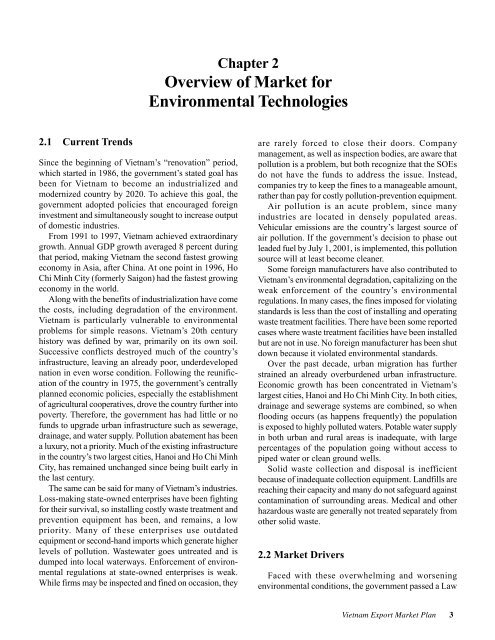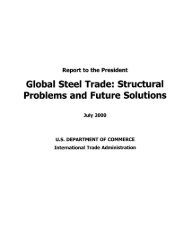Vietnam Environmental Technologies Export Market Plan
Vietnam Environmental Technologies Export Market Plan
Vietnam Environmental Technologies Export Market Plan
Create successful ePaper yourself
Turn your PDF publications into a flip-book with our unique Google optimized e-Paper software.
Chapter 2<br />
Overview of <strong>Market</strong> for<br />
<strong>Environmental</strong> <strong>Technologies</strong><br />
2.1—Current Trends<br />
Since the beginning of <strong>Vietnam</strong>’s “renovation” period,<br />
which started in 1986, the government’s stated goal has<br />
been for <strong>Vietnam</strong> to become an industrialized and<br />
modernized country by 2020. To achieve this goal, the<br />
government adopted policies that encouraged foreign<br />
investment and simultaneously sought to increase output<br />
of domestic industries.<br />
From 1991 to 1997, <strong>Vietnam</strong> achieved extraordinary<br />
growth. Annual GDP growth averaged 8 percent during<br />
that period, making <strong>Vietnam</strong> the second fastest growing<br />
economy in Asia, after China. At one point in 1996, Ho<br />
Chi Minh City (formerly Saigon) had the fastest growing<br />
economy in the world.<br />
Along with the benefits of industrialization have come<br />
the costs, including degradation of the environment.<br />
<strong>Vietnam</strong> is particularly vulnerable to environmental<br />
problems for simple reasons. <strong>Vietnam</strong>’s 20th century<br />
history was defined by war, primarily on its own soil.<br />
Successive conflicts destroyed much of the country’s<br />
infrastructure, leaving an already poor, underdeveloped<br />
nation in even worse condition. Following the reunification<br />
of the country in 1975, the government’s centrally<br />
planned economic policies, especially the establishment<br />
of agricultural cooperatives, drove the country further into<br />
poverty. Therefore, the government has had little or no<br />
funds to upgrade urban infrastructure such as sewerage,<br />
drainage, and water supply. Pollution abatement has been<br />
a luxury, not a priority. Much of the existing infrastructure<br />
in the country’s two largest cities, Hanoi and Ho Chi Minh<br />
City, has remained unchanged since being built early in<br />
the last century.<br />
The same can be said for many of <strong>Vietnam</strong>’s industries.<br />
Loss-making state-owned enterprises have been fighting<br />
for their survival, so installing costly waste treatment and<br />
prevention equipment has been, and remains, a low<br />
priority. Many of these enterprises use outdated<br />
equipment or second-hand imports which generate higher<br />
levels of pollution. Wastewater goes untreated and is<br />
dumped into local waterways. Enforcement of environmental<br />
regulations at state-owned enterprises is weak.<br />
While firms may be inspected and fined on occasion, they<br />
are rarely forced to close their doors. Company<br />
management, as well as inspection bodies, are aware that<br />
pollution is a problem, but both recognize that the SOEs<br />
do not have the funds to address the issue. Instead,<br />
companies try to keep the fines to a manageable amount,<br />
rather than pay for costly pollution-prevention equipment.<br />
Air pollution is an acute problem, since many<br />
industries are located in densely populated areas.<br />
Vehicular emissions are the country’s largest source of<br />
air pollution. If the government’s decision to phase out<br />
leaded fuel by July 1, 2001, is implemented, this pollution<br />
source will at least become cleaner.<br />
Some foreign manufacturers have also contributed to<br />
<strong>Vietnam</strong>’s environmental degradation, capitalizing on the<br />
weak enforcement of the country’s environmental<br />
regulations. In many cases, the fines imposed for violating<br />
standards is less than the cost of installing and operating<br />
waste treatment facilities. There have been some reported<br />
cases where waste treatment facilities have been installed<br />
but are not in use. No foreign manufacturer has been shut<br />
down because it violated environmental standards.<br />
Over the past decade, urban migration has further<br />
strained an already overburdened urban infrastructure.<br />
Economic growth has been concentrated in <strong>Vietnam</strong>’s<br />
largest cities, Hanoi and Ho Chi Minh City. In both cities,<br />
drainage and sewerage systems are combined, so when<br />
flooding occurs (as happens frequently) the population<br />
is exposed to highly polluted waters. Potable water supply<br />
in both urban and rural areas is inadequate, with large<br />
percentages of the population going without access to<br />
piped water or clean ground wells.<br />
Solid waste collection and disposal is inefficient<br />
because of inadequate collection equipment. Landfills are<br />
reaching their capacity and many do not safeguard against<br />
contamination of surrounding areas. Medical and other<br />
hazardous waste are generally not treated separately from<br />
other solid waste.<br />
2.2 <strong>Market</strong> Drivers<br />
Faced with these overwhelming and worsening<br />
environmental conditions, the government passed a Law<br />
<strong>Vietnam</strong> <strong>Export</strong> <strong>Market</strong> <strong>Plan</strong><br />
3
















